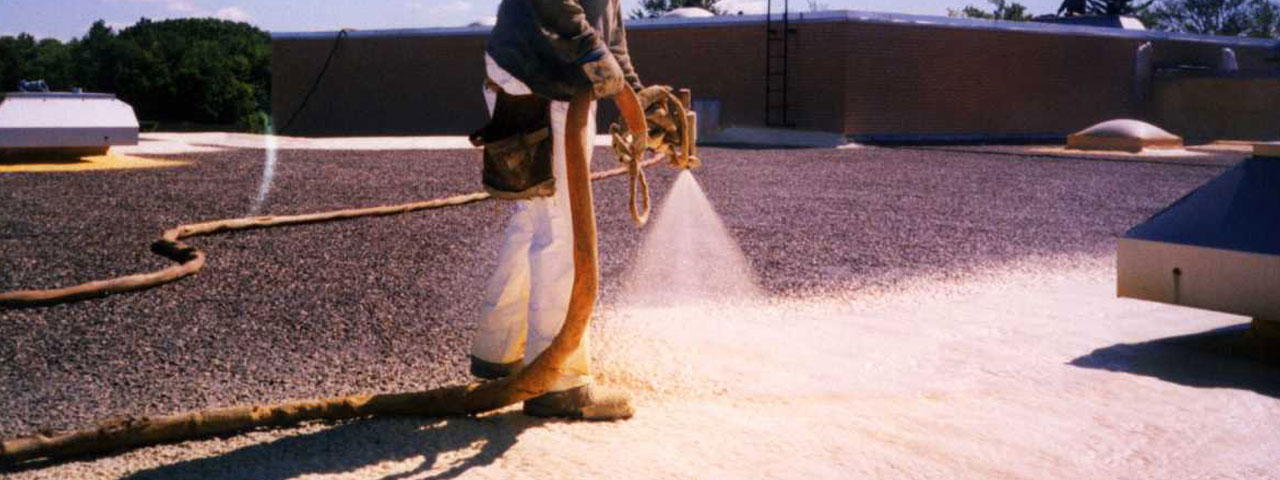what are spray foam roofing benefits?

Norfolk
Spray foam is an extremely versatile material, with regard to the substrates to which it can be adhered: concrete, wood, steel, and most every type of roofing material. SPF's versatility lends it a major advantage over competing materials when it comes to roofing repairs or replacement, as costly removal and landfill expenses can be avoided by simply applying SPF over existing roofing materials.
Spray foam is also a superior roofing material when it comes to installing a tapered roofing system, as installers can taper the roofing system with one material rather than involving several. SPF can also be spray-applied to cants and vertical wall terminations, making them integral components of the roofing system and minimizing expenses for supplemental materials.
A Protective, Monolithic Solid Roof Shell Derived from Liquid Foam
Using plural-component spray equipment, spray foam is applied as a liquid, which expands approximately 30 times its original liquid volume to for a hard, closed-cell monolithic roof surface that fills all cracks and crevices.
After it is applied to the roof surface, spray foam cures in a few seconds. While it completely adheres to the substrate, its expansion results in a weather tight roofing membrane. Spray foam is frequently utilized in remedial applications and adds little additional weight to the structure, given polyurethane's low mass.
A layer of protective elastomeric coating or gravel, which promotes a weather-resistant, durable, and protective surface that can be walked on for normal maintenance, is applied on top of the spray foam after the SPF has been applied to its finish specifications and proper thickness.
With 35 years as a maintainable roofing medium that adds excellent insulation value to building structures, spray polyurethane foam has a long history of energy efficiency that can be reflected in low utility bills.
Durabilty
A spray foam roof quickly dispels the preconceived notion that a "foam" roof is made up of soft foam, like the one found in seat cushions, and that could easily be damaged and require constant maintenance. Quite the contrary, SPF roofs are very durable and can handle construction and foot traffic well. Polyurethane caulking provides a simple fix when the SPF roof sustains any type of damage. Even though it is a rigid system, it can still sustain damage from dropped tools and the like.
R-Value From Density
Higher density in SPF means a higher R-value and increased strength, that's why density is important in terms of thermal resistance. Given the fact that exact numbers may vary depending on foam manufacturer, spray foam that is 3 lb. in density has an R-value of 7.14 when installed and 6.86 when it has aged with a comprehensive strength of about 50 psi. The range in cubic feet of your typical SPF roof is from 2.5 lbs. to 3 lbs. per cubic foot. To demonstrate just how well an SPF roof insulates, we've provided an example. Foam roofs where installed on some new, one-room relocatable classroom buildings in a Southern California school district. They installed the SPF roof systems on only some of the new buildings and not all just to see how well the SPF could perform. They installed 1.5 inches of 3 lb. density foam to the roof and added an acrylic coating system over the SPF. These classrooms were using their air conditioners at an average of 50 minutes every hour during the early spring and late fall. The buildings with the SPF roofs witnessed a 50 percent savings on energy costs, as the air conditioner usage was cut down to fifteen minutes every hour.
Lifespan
The lifespan of an SPF roof can be long, as long as the coating protecting the SPF is properly maintained. Depending on the amount of coating installed, the roof should be cleaned, primed, and recoated every 10 to 15 years. A quality SPF roof can last 50 years or longer if this is done.
SPF Roof Cost
Several factors revolve around the cost of an SPF roof, as it happens with every other type of roof. Typically, a basic SPF roof can start at approximately $2.50 per square. Cost can vary depending on things such as geographical location, the project's complexity, accessibility, foam thickness, and foam coating system.
Spray Foam Roofs' Protective Coatings
A protective layer, whether it is gravel or an elastomeric coating, is applied after the SPF has been applied to its finish specifications and proper thickness. The protective layer can be walked on for regular maintenance and it gives the roof a durable, weather-resistant surface.
Cool Roofs Program and Benefits of ENERGY STAR products
Roof coatings that can reduce energy bills by up to 50 percent and reduce the amount of air conditioning needed in buildings are ENERGY STAR qualified products. These are part of the Cool Roof Program which defines certain standards in roof coatings systems involving roof reflectivity and maintenance of reflectivity. These light-colored roof coatings lower the temperature of the roof by up to 100 degrees by reflecting the suns UV rays and heat.
Installing an SPF Roof
Different yet essential procedures based on existing roof structures Installation are involved in SPF roof installation, which is why it is important to be familiar with all local and state building codes to meet the requirements of a given area, and that the proper materials are used.

How can a SPF roof system improve your traditional roof system?
- Leak-free monolithic seal
- Self-flashing
- High insulation value
- Rapid payback with energy savings
- Strong adhesion
- Wind uplift resistance
- Weather resistant
- Lightweight and high strength
- UL and FM approved systems
Navigation
Areas of SERVICE
Our Norfolk spray foam contractors provide high-quality spray foam insulation services for residential and commercial applications and foam roofing services for industrial and commercial buildings near and throughout Virginia. We offer competitive spray foam insulation pricing in VA and ultimately help you save money on utility bills.
Call us today at 855-GET-FOAM(438-3626) for a free quote or estimate.
